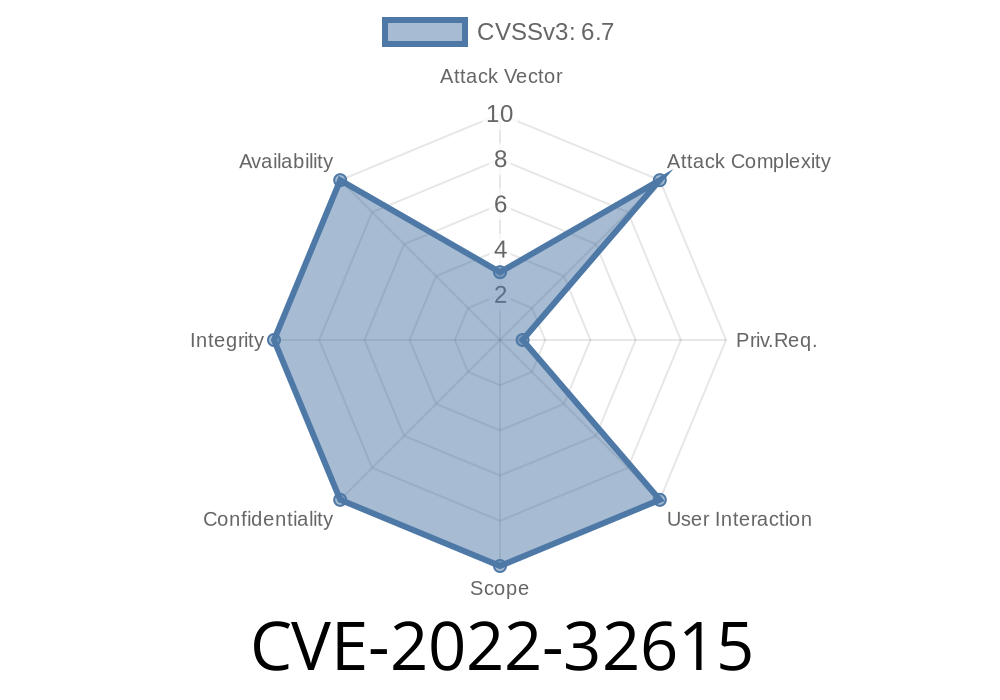A new vulnerability has been discovered, identified as CVE-2022-32615, which affects the CCD (Charge Coupled Device) component. This can potentially lead to local escalation of privilege by exploiting an out of bounds write issue caused by uninitialized data. The concerning factor is that user interaction is not required for the successful exploitation of this issue. The vulnerability has been assigned the Patch ID: ALPS07326559 and Issue ID: ALPS07326559.
In this post, we will provide an analysis of this vulnerability, providing a code snippet to demonstrate the issue, links to original references, and details on how the exploit works.
Code Snippet
Here's a simple example that demonstrates the out of bounds write issue due to the uninitialized data:
#include <stdio.h>
#include <stdlib.h>
int main() {
int *uninitialized_data;
int user_input;
uninitialized_data = (int *)malloc(10 * sizeof(int));
printf("Enter an index to write the data: ");
scanf("%d", &user_input);
if (user_input >= && user_input < 10) {
uninitialized_data[user_input] = 42; // Valid write
} else {
uninitialized_data[user_input] = 42; // Out of bounds write
}
free(uninitialized_data);
return ;
}
In the example above, the memory is allocated for an array of 10 integers by using the malloc function. The user is then prompted to enter an index to write the data. If the user-input index is not within the valid range (-9), an out of bounds write will occur and could potentially lead to a vulnerability.
Exploit Details
The exploitation of this vulnerability begins with the manipulation of uninitialized data within the CCD (Charge Coupled Device) component by writing out of bounds memory. This can be accomplished by utilizing a specific memory allocation that results in a situation where the allocated memory is neither fully initialized nor properly boundary-checked.
The attacker can subsequently exploit this out-of-bounds write to overwrite specific memory areas enabling an unauthorized elevation of privileges. Given that this vulnerability does not require user interaction, it poses a significant risk to the affected systems as it can be exploited silently.
Once an attacker has successfully escalated their privileges, they may gain unauthorized access to critical system functionalities or sensitive information, leading to further exploitation or data leakage. Since the vulnerability allows the escalation of privilege to the System execution privileges level, the attacker could exploit this to potentially take over the entire system.
Links to Original References
1. CVE Details: https://cve.mitre.org/cgi-bin/cvename.cgi?name=CVE-2022-32615
2. NVD (National Vulnerability Database): https://nvd.nist.gov/vuln/detail/CVE-2022-32615
Mitigation & Patch Information
The vulnerability has been assigned Patch ID: ALPS07326559 and Issue ID: ALPS07326559. It is recommended to apply the patch as soon as possible to protect your systems from possible exploitation.
To mitigate this issue, developers should always ensure that memory allocations are properly initialized and boundary-checked. Additionally, regular security audits and code reviews can help identify potential vulnerabilities in the software and reduce the risk of such issues going undetected.
In conclusion, CVE-2022-32615 is a serious vulnerability that could lead to local escalation of privilege through an out-of-bounds write due to uninitialized data within the CCD component. It is essential to apply the available patch and ensure that proper security measures are in place to minimize the risk of exploitation.
Timeline
Published on: 11/08/2022 21:15:00 UTC
Last modified on: 11/10/2022 15:04:00 UTC
